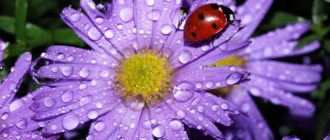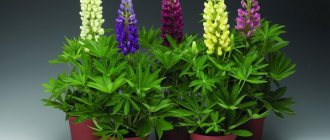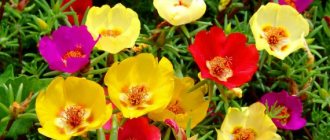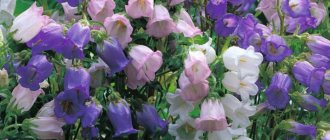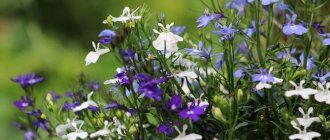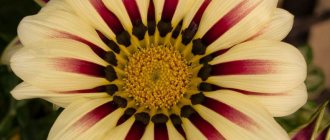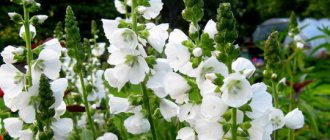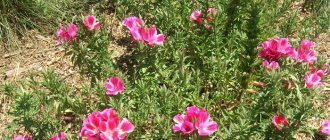The bright and cheerful Doronicum is enough to see even in the photo to imagine how it transforms the spring garden. This flower blooms early; already in mid-April and early May you can see its golden islands on home lawns. People lovingly call it “sunny daisy”; it also has a less euphonious name “kozulnik”. Caring for doronicum in open ground is not difficult, and since it is a perennial, planting it will not cause much trouble.
General description with photo
Doronicum is a representative of the Astrov family. It is found everywhere in Eurasia; you can often see its flowering meadows in northern Africa. It prefers to settle on mountain slopes, from which it becomes clear that this is a rather tenacious and unpretentious plant. It is a herbaceous perennial with a fibrous rhizome that lies superficially. The shoots are straight, leafy along the entire length, strong, with weak branching, capable of stretching up to a meter in height, but you can often find compact garden forms not exceeding 15 cm. The voluminous stem leaves are triangular in shape and alternate in arrangement, in a light shade of green. At the base, long-petioled leaves of a different, more rounded heart-shaped shape grow, forming a lush basal rosette. Both leaf blades have short, light pubescence.
Flowering occurs early, in the second half of spring. Chamomile-shaped, but slightly narrower petals are painted bright yellow. Flowers up to 12 mm in diameter bloom at the tips of the shoots and can be either single or formed into loose corymbose inflorescences. The photo of Doronicum flowers clearly shows the central lush core, which usually has the same color.
In place of the pollinated inflorescences, a miniature seed capsule no more than 2-3 cm in length is formed, inside which very small crested seeds ripen.
Doronicum seeds can remain viable for no more than 2 years.
Botanical features
Doronicum (Doronicum orientale) does not contain many species compared to others - about 40. These rhizomatous plants are perennials. The most commonly planted species are Caucasian, Oriental and plantain. The inflorescence is arranged like a basket. The central part consists of tubular orange or yellow flowers, and those on the edges are bright or pale yellow ligulate.
As a rule, inflorescences grow singly on long stalks. The height of Doronicum depends on the variety and can reach 10-15 centimeters, and sometimes 1.4-1.5 meters. There are also different sizes of inflorescences. Their value ranges from 4 to 12 centimeters.
The leaves are arranged differently depending on their height. Those located at the roots are attached like a rosette, and the stem ones are arranged in turn. The axils of the leaf blades on the stems may contain shoots with flowers. Although the plant begins to bloom earlier compared to other representatives of this genus, it also fades earlier. This feature is extremely important to remember, especially when creating flower beds. If it is provided with high-quality care, then flowers can appear again in one season, when childbirth ends.
Planting and propagation
If Doronicum is already growing on the site, the easiest way to propagate the planting is by dividing the bush.
Reproduction by division
This method is also preferable from the point of view of benefits to the plant itself, since transplantation with root division contributes to its rejuvenation. The fibrous superficial rhizome allows this to be done without damage. In addition, in older specimens with very overgrown clumps, the flowering is less lush, and the middle of the flowerbed may look poor and bald in terms of flowers. The optimal frequency of transplantation is 3-4 years.
You need to start dividing early in the spring after the snow melts. By this time, the first leaves may already appear on the perennial. The second acceptable period is the end of flowering. Theoretically, it is possible to replant doronicum in the fall, but experienced gardeners do not recommend doing this due to the lack of an above-ground part by this time. At the same time, if the flowerbed has already been covered by other, later flowers, there is no point in disturbing them.
The dug up bush, with all precautions, must be divided into self-sufficient parts along with roots and shoots. Usually it is enough to divide it in two. Planting of cuttings is carried out without deepening, i.e. to the same depth at the level of the root collar. The soil is pressed moderately tightly, watering is carried out and then it is very advisable to mulch the planting. Any classic materials are suitable for this - leaves, mown grass, sawdust, bark, humus, etc. This will eliminate additional weeding and watering, carefully preserving moisture.
Seed method
Seed material is planted in open ground in winter or early spring. It is also possible to use the seedling method, but this is not a mandatory measure. In winter, the sown seeds should be well covered with mulch, preferably high-moor peat or humus. In spring, the temperature sufficient for germination is +16C. In this case, seedlings will appear quite quickly, within 7-10 days. After they grow up and produce 1-2 pairs of leaves, they need to be picked and planted in a prepared place in open ground. The planting scheme for doronicum implies a distance of about 20 cm between the bushes.
Growing Doronicum from seeds
Sowing
Doronicum is grown from seeds through seedlings, and this is the most reliable method. However, seeds can also be sown directly into open soil; this is done before winter in late autumn or in May. Sowing of seedlings is carried out in April; for this purpose, a mesh tray is used, into which an earth mixture consisting of coarse sand and peat (1:1) is poured. 2 or 3 seeds are sown in one cell, then the container is covered with film (glass) and transferred to a place protected from direct sunlight (the light needs to be bright, but diffused). Caring for crops is very simple. To do this, they need to be systematically ventilated, remove accumulated condensation from the surface of the shelter, and, if necessary, moisten the soil mixture with a spray bottle.
Seedling care
If conditions are favorable, the first seedlings may appear 1.5–2 weeks after sowing. Immediately after this, the shelter is removed, while the plants are moved to a more illuminated place, but they are also protected from direct rays of the sun. If natural light is very poor, then a fluorescent lamp or phytolamp will have to be installed above the seedlings at a height of 20 to 25 centimeters from the container. Simple incandescent lamps are not suitable for this purpose, as they can overheat, and they also emit rays that cannot benefit the plants.
After the height of the plants is 40 mm, thinning is carried out. To do this, only one most developed seedling should be left in each cell, and the rest should not be pulled out, but cut with sharp scissors at the level of the substrate surface. To make the bushes more lush, when the seedlings have 3 or 4 leaves, you will need to pinch them.
Transfer rules
As already mentioned, it is advisable to replant doronicum bushes every 4 years, but the maximum period for its growth in one place is about 10 years. Overgrown doronicum means increasingly smaller flowers, thickened or, conversely, thinning areas, and frequent powdery mildew. The crop is not demanding on the composition of the soil, but you can see how much more luxuriantly these flowers bloom in flower beds rich in black soil. If the soil is too heavy and clayey, you can add rotted organic matter and sand to it.
About the plant
Dronicum leaves are located close to the root system and seem to “hug” the stems. They go in a certain order. Flowering occurs in different ways. This can be one flower or several (up to six) pieces of peculiar “shields”.
The form is either a “wide bell” or blooms into a beautiful hemisphere. The leaves wrapped in basket-inflorescences form two sometimes three rows.
The flower is characterized by the presence of both sexes. They are concentrated in the middle part. Along the edges of them are located in one row yellow female segments.
Dronicum bears fruit with blunt shaped achenes.
Care
These unpretentious and unpretentious flowers are not at all difficult to care for. They are content with partial lighting, however, they will not feel well under dense trees or on the north side of buildings. Sunny chamomile is resistant to summer heat and cold winters, so it is not necessary to cover the bed in winter, with the exception of abnormally cold snowless winters. But even in this case, it is enough to rake fallen leaves onto the bed. In summer they can be watered en masse in case of prolonged absence of rain. Even if there is no possibility of regular watering, Doronicum will not die. And yet, regular and fairly shallow watering will be the ideal condition for successful flowering. During the rest period it is no longer important.
Doronicum flowers are suitable for cutting and can stand in a vase for a long time.
Feeding
If the soil in the garden is sufficiently fertile, you can do without fertilizing, but the plant will respond positively to a one-time application of the mineral complex before flowering. In spring and/or autumn, you can add well-rotted organic matter during the general preparation of the site for the season.
Self-seeding
Kozulnik is prone to self-seeding, which, on the one hand, makes it easier to reproduce, but on the other hand, creates certain inconveniences due to weeds and denseness of the site. To prevent this from happening, faded buds must be torn off before the seed pods ripen. This will also benefit the decorative effect of the flowerbed.
Conditions
Caring for doronicum includes not only watering and tillage, but also choosing suitable conditions. Care must be taken to ensure that the plant is neither too cold nor too hot, and that the soil is sufficiently nutritious for it.
Place on site
Doronicum loves sunlight, but not so much that it can withstand direct exposure to rays, so it needs to be placed in partial shade. It is better to choose a place distant from trees, otherwise the flower will lack nutrients. Interestingly, plantain plantain is the only plant species that not only tolerates bright sun, but also grows best under its rays.
The soil
The soil should be loose and fertile, with neutral acidity (to obtain it, just scatter limestone or dolomite flour on the site towards the end of autumn). Sandy and loamy soils are suitable.
Types and varieties with photos
Among the many natural varieties of Doronicum, only a few are used in gardening, on the basis of which breeders develop numerous varietal lines with attractive decorative qualities.
Doronicum eastern
In its basic wild form, it can be seen in the foothills of the Caucasus, in the Mediterranean region, Asia Minor and some European countries with a warm and mild climate. It grows up to half a meter, the flowers are numerous, not large, up to 5 cm. It begins to bloom later for its group, in early May, flowering continues for just over a month (about 40 days). After the last buds fade, the entire above-ground part of the plant dies. The most famous varieties:
- Magnificum - tall, with larger flowers.
- Spring Beauty is a relatively compact variety valued for its double inflorescences.
- Goldcut is another terry line, but grows up to 60cm.
- Finesse - the flowers have a very delicate light yellow tint.
- Gold Dwarf is short, no taller than 15 cm, looks great in the border.
Doronicum plantain
It is very widespread throughout Southwestern Europe. In many countries it is known by another name - Leopard's Bane. This is a very tall variety of crop that can reach 1.5 meters in height. The appearance of the basal leaf rosette is very similar to plantain. Due to its high growth, it blooms even later, towards the end of May, and has the same flowering duration of about 40 days. Some artificially bred varieties, such as Excelsium, bloom a little longer.
Doronicum Columna
It has several other botanical names - columnar, heart-leaved or heart-shaped. The natural distribution area is the Balkans, Asia Minor, southern Europe. But you can rarely find it in the wild. Most representatives are short, 15-30cm. Blooms in single inflorescences with narrow elongated reed petals. It blooms profusely for about a month, after which it immediately dies off until next year. It tends to grow strongly and form dense clumps.
Doronicum grandiflora
You can find it in nature high in the mountains, but the plant itself is low-growing, with single, fairly large inflorescences of a dark yellow hue. Due to the nature of its natural growth, it blooms not in spring, but in mid-summer. Continues to open buds throughout the month.
Use in landscape design
Due to early flowering, you can see bright yellow islands of blooming doronicum in the garden on bare soil after winter, and this immediately gives the area a spring-festive look. However, after flowering ends, the place looks unsightly, since the above-ground part of the plant dies off. Therefore, it is recommended to plant “sunny daisy” in company with other perennials that bloom later and bloom until the coldest weather, in order to decorate the flowerbed for the entire garden season. Marigolds, irises, and primroses are perfect for this role. Low-growing varieties look great in borders. Externally, the plant goes very well with ferns and Volzhanka, as well as many other commensurate decorative foliage crops.
How to care
Even a novice hobbyist will find it easy to provide appropriate care for the plant. When the flowers fade after flowering, they need to be cut off. Then the look will be fresh and bright and will not lose its attractiveness.
At the end of September, you need to choose the right time to rejuvenate the Doronicum. This is done so that the flowers do not become smaller and smaller over time. For this purpose, the selected bushes must be divided into several parts and then planted.
Then the flower garden will always look neat and attractive, and the plants will delight you with their bright and large baskets. This is facilitated by the annual implementation of such a procedure.

